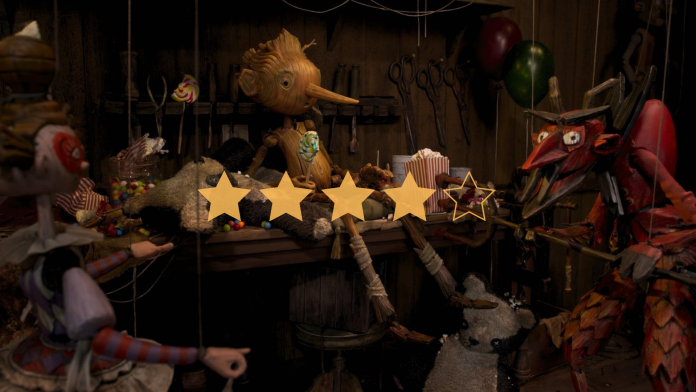This film is being screened as part of the 2022 BFI London Film Festival. You can find all of our coverage of the festival here.
From the visionary that brought us, Nightmare Alley and the Best Picture Oscar Winner, The Shape of Water, Guillermo Del Toro reinterprets the classic tale of the titular wooden boy, with his stop-motion animated debut.
★★★★✰
Monsters, fairy tales, horror, gothic settings, and the thoughtful visual splendour of fantasy. The amalgamation of all of these elements can be notably attributed to one mind: Guillermo Del Toro. With his countless stories exploring the underlying beauty of fantasy, Del Toro’s films often additionally feature harsh and tumultuous historical backdrops as a though-provoking escapist metaphor. For instance, Pan’s Labyrinth occurs during the Francoist dictatorship in Spain and The Shape of Water takes place during the Cold War. This exploration is no exception with Guillermo Del Toro’s Pinocchio.
Based on the classic children’s book from Carlo Collodi, the film follows the timeless tale of the titular wooden puppet (Gregory Mann) and his adventures whilst struggling to become a real boy and meeting his father, Geppetto’s (David Bradley) expectations. Del Toro’s adaptation, however, showcases several deviations and stylistic presences. It is set during 1930’s Fascist Italy and highlights the political grievances of this period and is largely a much more mature take on this classic story. Guillermo Del Toro’s Pinocchio further derives influence from Gris Grimly’s 2002 version of the tale, including his distinctive Pinocchio design and Grimly serving as an executive producer.
All of these noteworthy stylistic and unique creative choices combined, succeed in constructing a harsher and grounded version of Pinocchio, whilst maintaining the original story’s moralistic themes in this gorgeous adaptation.
One of the key pinpoints when attempting a classic tale such as: Pinocchio, is the particular design in which the adaptation is presented. In collaboration with production companies, ShadowMachine (BoJack Horseman) and The Jim Henson Company (The Muppets), Pinocchio is revitalised with the advantage of stop motion animation. Frame by frame, the wooden puppet’s adventures are illustrated beautifully through this animation medium. Every moment and every sentiment translate magnificently through the vibrant designs of the architecture and meticulous landscape embodied throughout the story. Since 1930’s Fascist Italy serves as the overarching political and societal atmosphere, images of dictatorship, oppression and war develop into unnervingly striking depictions. But then when the story articulates a joyful moment, the backdrops alleviate the frame with their vivid colours and detail.
Each emotion that is necessary for a part of Pinocchio’s journey is elevated through the remarkable stop motion animation exhibited over the course of the film. Every character’s personality is meticulously revealed through their delightfully conceived designs that articulate their qualities and feelings. Pinocchio’s design for instance, expresses everything the audience is required to know. He is wooden, simple and lacks colour which connotes his desire of self-actualisation and lack of life experience. He feels like a proper wooden puppet and his carefully communicated appearance fully demonstrates this.
Alongside gorgeous animation, what is most significant is how this adaptation of Pinocchio delivers in its representation of the classic story. Whilst the core narrative rhythms generally remain the same, this is fundamentally a harsher take on the timeless tale. Mature ideas such as, mortality, stark realities of wartime, and loss are highlighted through this version. This leads to a more sombre yet very touching reinterpretation that extends far beyond a story of a wooden puppet’s adventures. A fine example of this is demonstrated through Geppetto’s perspective in Pinocchio’s journey. Initially, he builds the puppet out of sorrow regarding the loss of his son. However, in this version this aspect is delved into considerably with flashbacks of losing him during WW1, and the fact that Geppetto sinks into drunkenness whilst building Pinocchio. Plot elements such as these, aid in effectively creating an adaptation with more emotional immensity and dramatic poignancy.
Since Del Toro frequently investigates comparisons between bleak realities and fantastical worlds, discussions of morality are communicated efficiently in this version. Guillermo Del Toro’s Pinocchio bares similarities to one of Del Toro’s other fantasy offerings: Pan’s Labyrinth. In that narrative, a young girl ventures into an imaginary realm to evade her evil tyrannical stepfather and the brutal experiences of Francoist Spain. Wartime metaphors play a huge role in underpinning Pinocchio’s journey as these parallels between wonder and horror exquisitely translate the thematic core of his adventures. They further illustrate one of the film’s crucial messages of continuing and empowering your true self instead of other superior forces influencing their perceptions onto yourself.
While these examinations of morality, loss and self-actualisation are incredibly ripe in this version, the one downside is the musical elements in this story. This film features several original songs and is a part-musical adaptation of Pinocchio. There is nothing improper about adapting Pinocchio into this particular genre for film, but the problem lies with the execution. Each of the songs are respectable at the greatest and midway through, the film completely neglects that was a musical and showcases no songs. What would have benefited Guillermo Del Toro’s Pinocchio, would be to scrap the musical motifs and solely focus on its key ideas in order for the central themes to fully resonate.
Verdict
Guillermo Del Toro’s Pinocchio is yet another success in Del Toro’s filmography that recites the classic story with profoundness and emotional tenderness. Regardless of the understated musical elements, its breathtakingly stunning animation and mature reinterpretation of Pinocchio constructs an especially powerful film that will leave audiences emotionally satisfied.
Words by Ethan Soffe
Support The Indiependent
We’re trying to raise £200 a month to help cover our operational costs. This includes our ‘Writer of the Month’ awards, where we recognise the amazing work produced by our contributor team. If you’ve enjoyed reading our site, we’d really appreciate it if you could donate to The Indiependent. Whether you can give £1 or £10, you’d be making a huge difference to our small team.
